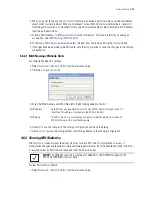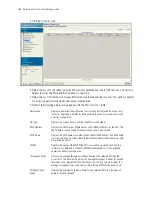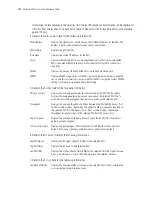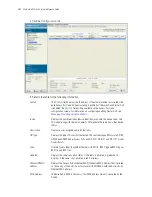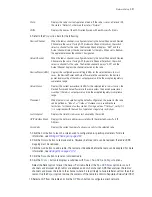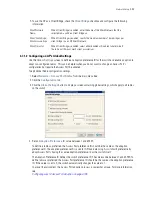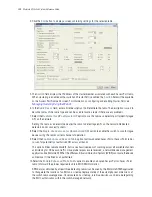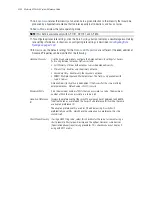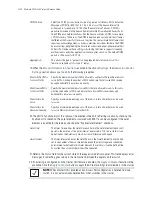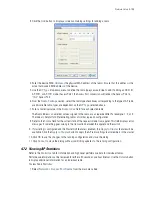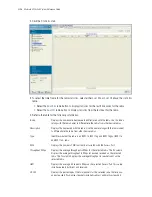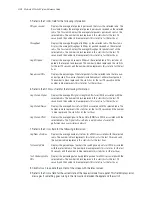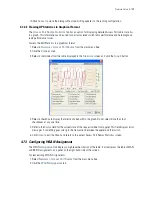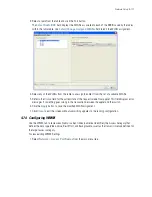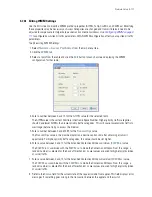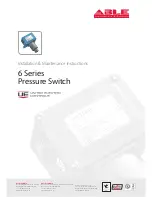
Network Setup
4-99
11.The following read-only information is displayed:
12.To add the radio to a Radio Group, enter the
Group Id
for the radio group you wish to add it to. For more
information on configuring Radio Groups, see
Configuring Radio Groups for MU Load Balancing on page
4-114
.
13.From within the
Radio Settings
field, define the
Placement
of the Access Port as either
Indoors
or
Outdoors
.
An Access Port can be set for Indoors or Outdoors use depending on the model and the placement
location. Power settings and channel selection options differ based on each country's regulatory rules
and whether or not the unit is placed indoors or outdoors.
Channel Width
is the distance between two channels in the same frequency. This difference is
measured in MHz. For type ‘an’ channels, the channel width is either 20 MHz or 40 MHz. For type ‘bgn’
channels, the width is 20 MHz. This field is read-only and is available only with type ‘n’ radios.
Desired Channel (sec)
is
the channel for communication between the Access Ports and MUs using the
secondary radio of an AP having multiple radios. The selection of a channel determines the available
power levels. The range of legally approved communication channels varies depending on the
installation location and country. The selected channel can be a specific channel, Random, or ACS.
Random assigns each radio a random channel. ACS (Automatic Channel Selection) allows the switch to
systematically assign channels. Default is Random.Select a channel for communications between the
Access Port and its associated MUs within the
Desired Channel
field.
The channel for communication between the Access Port and its associated MUs can be using the
primary radio or the secondary radio of an AP. Accordingly the channel is called
Desired Channel
(Pri)
or
Desired Channel (Sec)
respectively.The selection of a channel determines the available power
levels. The range of legally-approved communication channels varies depending on the installation
location and country. The selected channel can be a specific channel, “Random,” or “ACS.” Random
assigns each radio a random channel. ACS (
Automatic Channel Selection
) allows the switch to
systematically assign channels. Default is Random.
14.After first selecting a channel, select a power level in dBm for RF signal strength in the
Desired Power
(dBm)
field.
The optimal power level for the specified channel is best determined by a site survey prior to installation.
Available settings are determined according to the selected channel. Set a higher power level to ensure
RF coverage in WLAN environments that have more electromagnetic interference or greater distances
between the Access Port and MUs. Decrease the power level according to the proximity of other Access
Ports. Overlapping RF coverage may cause lost packets and problems for roaming devices trying to
connect to an Access Port. After setting a power level, channel, and placement the RF output power for
the Access Port is displayed in mW. The default is 20 dBm (802.11bg), 17 dBm (802.11a).
MAC Address
The Base Radio MAC is the radio's first MAC address when it is adopted by the
Switch.
Radio Type
Radio type identifies whether the radio is an 802.11b, 802.11bg and 802.11bgn or
802.11a and 802.11an radio.
Config Method
The Config Method displays whether the radio has been configured using static or
dynamic settings.
NOTE:
After setting a power level, channel, and placement, the RF output power for the
Access Port displays in mW.
Summary of Contents for RFS Series
Page 1: ...M Motorola RFS Series Wireless LAN Switches WiNG System Reference Guide ...
Page 10: ...TOC 8 Motorola RF Switch System Reference Guide ...
Page 56: ...2 8 Motorola RF Switch System Reference ...
Page 334: ...5 52 Motorola RF Switch System Reference 2 Select the MU Status tab ...
Page 510: ...7 32 Motorola RF Switch System Reference Guide ...
Page 534: ...8 24 Motorola RF Switch System Reference Guide ...
Page 570: ...C 14 Motorola RF Switch System Reference Guide ...
Page 589: ......

